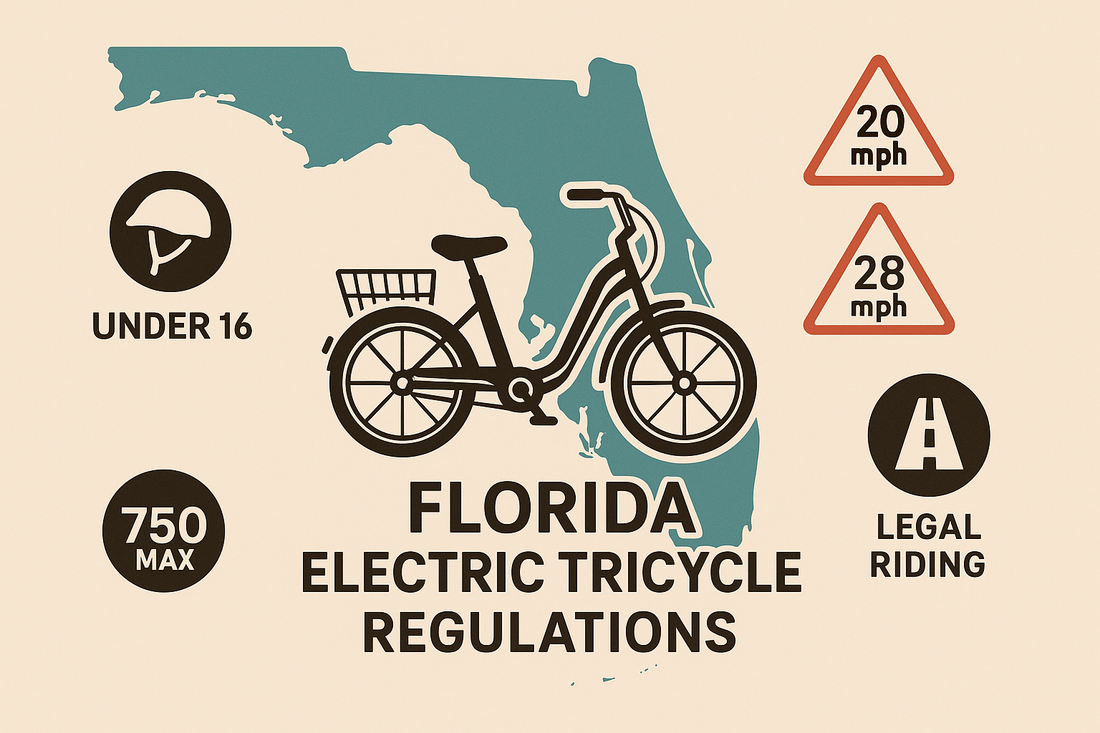
Florida Electric Tricycle Rules Explained
Table of Contents
Buying—or renting—an electric tricycle (e-trike) in the Sunshine State? Before you cruise Miami Beach or pedal the Keys, you’ll need to know how Florida classifies e-trikes, what speed caps apply, and where you can legally ride. This guide distills the statutes, 2025 updates, and local ordinances so you can stay worry-free on every ride.
What Counts as an “Electric Tricycle” in Florida?
Under Florida Statute § 316.003(23), an electric bicycle or tricycle is “a bicycle or tricycle equipped with fully operable pedals, a seat or saddle, and an electric motor ≤ 750 W” that meets Class 1, 2, or 3 speed definitions. leg.state.fl.us
-
Class 1: Pedal-assist only, 20 mph max
-
Class 2: Throttle or pedal-assist, 20 mph max
-
Class 3: Pedal-assist only, 28 mph max and speedometer required
If your three-wheeler exceeds 750 W or 28 mph, it moves into moped or motorcycle territory and must be registered, titled, and insured. leg.state.fl.us
Licensing, Registration & Insurance
Good news: properly classified e-trikes don’t need a driver’s license, tag, or insurance. They’re treated like traditional bikes.
But exceed the Class 3 limits or remove the pedals and you’ll trigger moped rules under § 322, which means plates, insurance, and an “E” endorsement.
Age & Helmet Requirements
-
No minimum riding age—the 2025 update removed Florida’s previous 16-year restriction. tampalaw.com
-
Helmets: State law only mandates them for riders under 16. All ages must wear one if the trike exceeds 20 mph or is operated on streets with > 35 mph speed limits (local rule in Miami-Dade). Always check county ordinances.
Where You Can Ride
| Location | Class 1 & 2 | Class 3 | Notes |
|---|---|---|---|
| Streets & bike lanes | ✅ | ✅ | Follow bicycle traffic laws |
| Shared-use paths | ✅ | ⚠️ Local option | Some counties ban Class 3 on crowded boardwalks |
| Sidewalks | ⚠️ | ❌ | Sidewalk use is legal for bikes only if speed ≤ 15 mph and pedestrians have priority (many cities restrict e-trikes) |
| State highways | ⚠️ | ⚠️ | Allowed unless posted otherwise; shoulder riding recommended |
Florida lets e-trikes “operate wherever bicycles are allowed,” but cities can add stricter rules—St. Petersburg and Key West, for instance, limit Class 3 trikes on Old Town streets after dark.
Speed & Power Limits
-
Motor power: ≤ 750 W continuous
-
Max assisted speed: 20 mph (Class 1 & 2), 28 mph (Class 3)
-
Tampering with firmware to exceed limits reclassifies the vehicle—troopers do check speeds in popular beach areas.
Guide to Upgrading Your E-Bike Without Breaking the Law
Required Equipment
-
Pedals—must remain installed and operable
-
Front white light & rear red light/reflector (sunset to sunrise)
-
Class 3 speedometer—displaying current speed in mph
-
Brakes—capable of stopping within 25 ft from 10 mph on dry pavement
-
Audible warning device (bell or horn) on roads with speed limits > 25 mph
Tips for Staying Compliant
-
Carry proof of class: a spec sheet or manual showing 750 W motor & top speed helps in roadside checks.
-
Use geo-locked speed settings: many e-trikes let you swap from 28 mph to 20 mph mode for path riding.
-
Verify local rules before vacation rides—Naples, Fort Lauderdale, and Orlando all publish e-bike ordinances online.
-
Ride right & signal: Florida yields full lane rights to bikes, but hugging the right curb avoids road-rage incidents.
Frequently Asked Questions
Q: Do I need to register my electric tricycle in Florida?
A: Not if it meets Class 1–3 limits (≤ 750 W, ≤ 28 mph). Otherwise, it’s classified as a moped or motorcycle and must be plated.*
Q: Can I ride my e-trike on Florida sidewalks?
A: Only if local ordinances allow it and you yield to pedestrians; Class 3 trikes are usually restricted to streets or bike lanes.*
Q: Is a helmet mandatory for adults on e-trikes?
A: State law says no, but counties can require helmets on higher-speed roads. Riders under 16 must wear one everywhere.*
Q: Are throttle-only trikes legal?
A: Yes—if limited to 20 mph they fall under Class 2 rules. Anything faster becomes a moped.*
Q: What happens if I remove the pedals?
A: The vehicle is no longer a “bicycle/tricycle” under § 316.003 and will be classified as a moped, requiring registration and insurance.*
No comments











0 comments